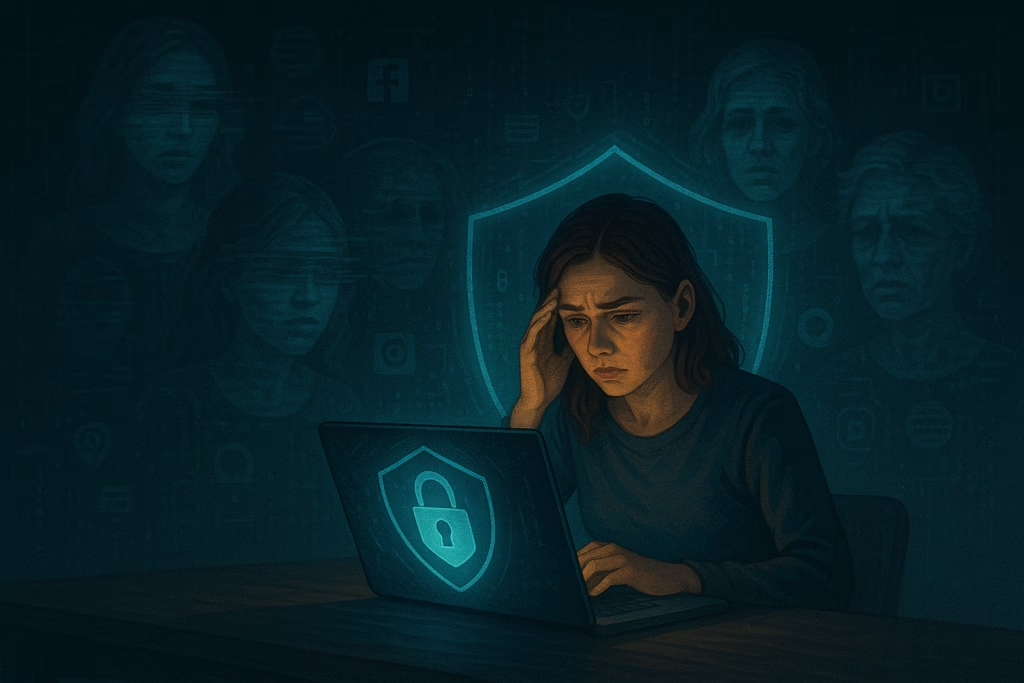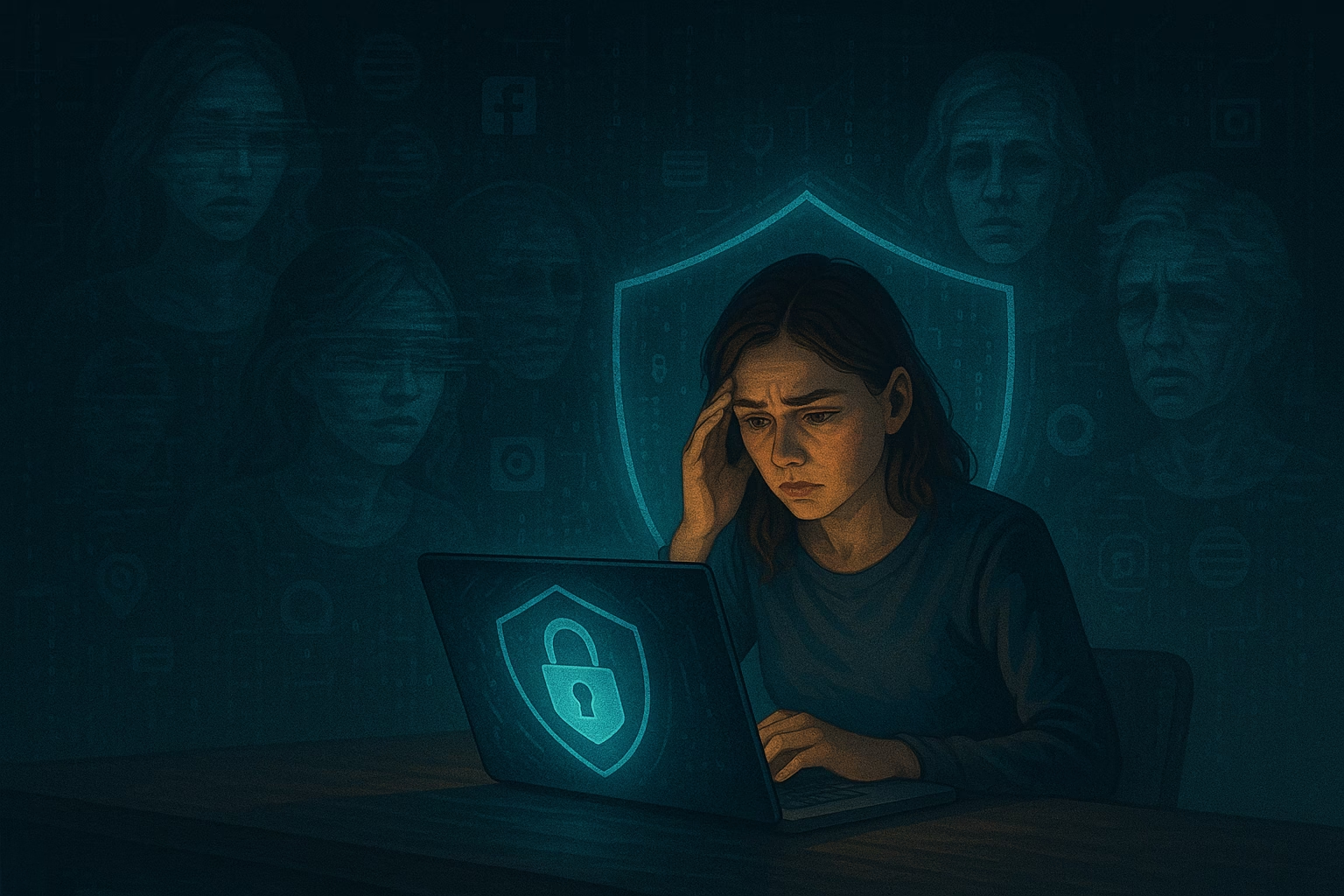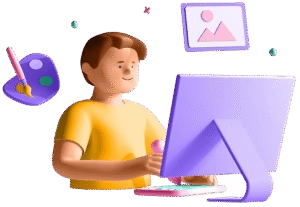In an era where technology can replicate your face, voice, and even behavior using artificial intelligence, the risk of image misuse has reached dangerous heights. Discovering your private images have been leaked, maliciously morphed, or used in deepfakes and been circulating on Internet can feel like a profound violation – a digital nightmare that shakes your sense of peace. You might feel overwhelmed, angry, scared, or exposed. This article features actionable steps you can take right now to regain control over your media, leveraging powerful tools like TakeItDown.org, StopNCII.org and Google’s Content Removal Form.
The Real Threat: Understanding Leaked, Morphed, and Deepfake Images
Before going into solutions, it’s important to understand the threats:
- Leaked Images: These are private, often intimate, photos or videos shared without your consent. This can be a result of a data breach, a hack, or a betrayal by someone you trusted.
- Morphed Images: These are genuine images that have been digitally altered, often to place your likeness in a compromising or false context.
- Deepfakes: This technology uses artificial intelligence (AI) to create highly realistic but entirely fake videos or images, often superimposing a person’s face onto another body or making them appear to say or do things they never did. The sophistication of deepfakes makes them particularly insidious.
The impact of these violations can be devastating, leading to reputational damage, severe emotional and psychological distress, harassment, and a long-lasting shadow over your life. The scale of the problem is significant:
- Studies indicate that a vast majority of deepfake content online is non-consensual and pornographic, disproportionately targeting women (Sources: Home Security Heroes 2023, OPDV NY 2024).
- The Revenge Porn Helpline in the UK reported nearly 19,000 cases of image-based abuse in 2023 alone, a dramatic increase over previous years, highlighting the escalating crisis (Source: UK Parliament, Hansard, Nov 2024).
- Globally, a significant percentage of women report experiencing some form of image-based abuse or online harassment (Sources: UN Women, OPDV NY).
These statistics aren’t just numbers; they represent real people whose lives are deeply affected. But technology also offers pathways to fight back.
Ways to control your media with StopNCII.org
If you’re dealing with intimate images (nude, semi-nude, or depicting a sexual act) that have been shared or you fear might be shared without your consent, StopNCII.org (Stop Non-Consensual Intimate Image Abuse) is a crucial first line of defense.
What is StopNCII.org and Why is it Powerful?
StopNCII.org is a free, global tool that helps prevent the proactive spread of your intimate images online. An initiative by the UK-based nonprofit “SWGfL” in partnership with major global platforms to block these images from being shared on their platforms. Its power lies in its privacy-focused approach: your images never leave your device.
🔒 Is It Safe? Yes. Because.
- Your images never leave your device
- The site uses “hashing” – a digital fingerprint of your image
- No one—not even StopNCII—sees your actual photos
- It’s confidential, free, and secure
Who is it For?
- Individuals aged 18 or older. (Please refer Link if you are under 18)
- Whose intimate images/videos (where they are depicted) are being shared or are at risk of being shared without consent.
- Who are still in possession of the original images/videos.
How to Use StopNCII.org to Protect Your Images (Step-by-Step):
- Visit the https://stopncii.org/.
- Click on “Create Your Case.”
- You’ll be asked a few simple questions to ensure you and your content meet the criteria (e.g., you are over 18, the image is of you and is intimate, you have the image).
- Select Your Images/Videos: Choose the specific intimate image(s) or video(s) from your device that you want to protect. Remember, these files are not uploaded to StopNCII.
- Generate Hashes: The StopNCII tool will then create a unique digital fingerprint (a “hash”) for each image/video directly on your device. This hash is a string of numbers and letters that is unique to that specific image.
- Submit the Hashes: Only these hashes are sent to StopNCII. The actual images/videos remain securely on your device.
- You will be given a case number and will need to create a PIN. WRITE THESE DOWN AND KEEP THEM SAFE! This is the only way you can check the status of your case or withdraw your hashes later. StopNCII does not store your email or this information, ensuring your privacy.
- Partner Companies Take Action: StopNCII shares these hashes with participating tech companies (social media platforms, etc.). These companies will then use these hashes to detect and remove or block any attempts to upload matching content if it violates their policies.
What to Expect After Submitting a Case:
Participating companies will actively look for matches to your hashes and take action. You can use your case number and PIN to check the status on the StopNCII website. This is an ongoing process designed to prevent the further spread of these images.
Fighting Back on Google Search: Using the Content Removal Form
What if your images are appearing in Google Search results, even if they are on third-party websites? Google offers a Content Removal Form for these situations to remove media from Search Results (it does not remove content from Source website, it only helps to reduce visibility from Google Search Results).
Best Scenarios for Using Google’s Content Removal Form:
- You are able to find your content on Google Search even if it is posted on any third-party website.
- You want to take quick action to limit the visibility of this content in search results to protect your reputation and reduce further exposure.
Step-by-Step: Requesting Image Removal from Google (Using the General Form Principles):
- You can find Google’s content removal tools by searching “Google remove content from search“.
- Specify the Reason: The form will ask you why you are requesting the removal. Choose the option that best fits your situation (e.g., it contains your personal information, it’s non-consensual explicit content, etc.).
- Provide URLs: This is crucial.
- You’ll need the URL of the webpage(s) where the image appears.
- You’ll also need the URL of the Google search results page showing the link to that content.
- For images, you may need the direct URL of the image itself (often found by right-clicking the image in search results and selecting “Copy image address”).
- No Technical Jargon Needed: As you rightly pointed out, these forms are designed for everyday users. Explain your situation clearly and simply.
- Submit and Wait: Response times can vary, often within a few days, but some cases may need more verification. Google will notify you of their decision.
TakeItDown.org – A Tool for Minors Facing Image-Based Abuse
If you’re under 18 and your intimate or personal images have been shared online without your consent, TakeItDown.org is a free and secure tool to help you remove such content from the internet.
What is Take It Down?
TakeItDown.org is a global platform run by NCMEC (National Center for Missing & Exploited Children), created to help minors (or their guardians) anonymously report and take action against the sharing of sensitive content, such as,
-
Leaked or stolen images
-
Morphed/altered intimate content
-
Deepfake nudes of minors
-
Non-consensual recordings
How It Works (Without Uploading Your Image):
-
You don’t upload the image itself.
-
Instead, the platform creates a unique hash (digital fingerprint same as StopNCII) of your image or video.
-
That hash is shared with participating platforms (like Meta, Facebook, Instagram, etc.).
-
These platforms search and remove existing matches and prevent future uploads of that same image or video.
This means your privacy is protected: no one sees the actual image, but it still tracks and removes the images from platforms.
Who Can Use It?
-
Anyone under 18
-
Parents or guardians on behalf of a minor
-
Individuals who were underage when the image was taken, even if they’re now 18+
By using these platforms together—TakeItDown.org, StopNCII.org, and Google’s Removal Tools—you can take real steps toward protecting your privacy and getting harmful content removed from the internet.
The challenges you might be facing are part of a broader view of technological misuse. As explored in the article “NCSII – The Dark side of Technology: Leaked, Morphed, and Deepfakes” the ease with which malicious actors can create and distribute harmful, unauthorized content like deepfakes and manipulated images is a growing concern.
Beyond the Tools: Essential Next Steps & Support
Taking down images is a critical step, but your well-being encompasses more. Consider these additional avenues for support:
Legal Support:
Helplines and Reporting Portals by Country
🇮🇳 India
- Cyber Crime Portal: cybercrime.gov.in
- Report: Go to the “Report Women/Child Related Crime” section for faster response.
- Helpline: 📞 1930 (24×7 National Cyber Crime Helpline)
🇺🇸 United States
- NCMEC CyberTipline: report.cybertip.org
- Take It Down (for minors): takeitdown.ncmec.org
- FBI IC3 (Internet Crime Complaint Center): ic3.gov
- Helpline for victims of image abuse: 📞 1-888-373-7888 (National Human Trafficking Hotline)
🇬🇧 United Kingdom
- Revenge Porn Helpline: revengepornhelpline.org.uk
- Phone: 📞 0345 6000 459
- Email: help@revengepornhelpline.org.uk
- Also provides hash-matching tools and helps with image removal.
🇨🇦 Canada
- Cybertip.ca: www.cybertip.ca
- Phone: 📞 1-866-658-9022
- Provides help for minors and adults dealing with non-consensual content.
🇦🇺 Australia
- eSafety Commissioner (Office of eSafety): esafety.gov.au
- Image-Based Abuse Reporting: Report here
- Phone: 📞 1800 880 176 (eSafety Women support line)
🇩🇪 Germany
- Jugendschutz.net (Youth Protection): jugendschutz.net
- Image-based abuse complaints: Internet complaint office
- Police: 📞 110 (Emergency) / local cybercrime units via state websites
🇫🇷 France
- Pharos Platform (Online Harm Reporting): internet-signalement.gouv.fr
- Gendarmerie Nationale: Can report in-person or online.
🇸🇬 Singapore
- Anti-Scam Helpline: 📞 1800-722-6688
- Police e-services: police.gov.sg
- Support for victims of cyber abuse: samaritans.org.sg
🌍 Global Support (Any Country)
- StopNCII.org: For adult victims of non-consensual intimate image sharing.
- TakeItDown.org: For minors worldwide (under 18) experiencing image-based abuse.
- Cyber Civil Rights Initiative (CCRI): cybercivilrights.org
- 📞 Helpline: 844-878-2274 (U.S.-based but accepts global queries)
Dealing with leaked or morphed images can be traumatizing, but please know that you have legal, technical, and emotional support available. Whether you’re seeking removal, justice, or someone to talk to, reach out. Help is available.
Let me know if you’d like to include WhatsApp-based support, Telegram bots, or country-specific NGO recommendations as well. I can also format this into a downloadable PDF guide or sidebar box for your blog.
- Emotional and Mental Health Resources:
- This experience is traumatic. It’s okay to seek help.
- Helplines: Many organizations offer free, confidential support. Search for mental health helplines or cyberbullying support lines in your region. (e.g., In India, resources like iCALL Psychosocial Helpline, Vandrevala Foundation, Aasra, or Tele MANAS can be contacted. Various organizations like The Cyber Helpline or the National Domestic Violence Hotline offer support).
- Counseling/Therapy: Speaking with a mental health professional can provide you with coping strategies and a safe space to process your emotions.
Remember to document and take evidence of everything: Take screenshots of the abusive content, available data, note URLs, dates, and any communication with perpetrators or platforms. This evidence is vital if you pursue legal action.
Get Back Your Digital Identity
Finding your private images exposed or manipulated online is a deeply horrifying experience. But as you’ve seen, there are concrete actions you can take. Tools like StopNCII.org and Google’s Content Removal Form are vital resources in your fight to help you recover your privacy.
This isn’t just about removing content from Internet, it’s about reclaiming your peace of mind and standing against abuse. Act quickly, contact your trusted one’s and remember that it’s not your fault at all. You have the power to take control and move forward.





